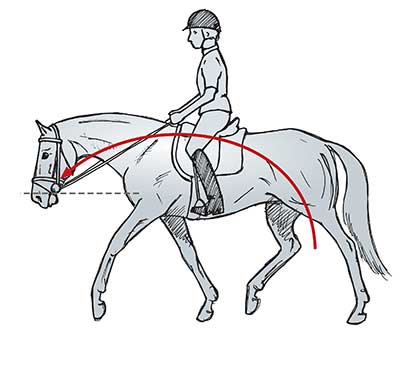
by Christoph Hess
Correctly stretching a horse is one of the most significant elements of training. Having said that, only a horse that is engaged from behind and stepping up actively is going to be able to adapt a correct long and low position. There are ways that a rider can support this process.
The “long and low” stretch is a significant factor in the training of every young horse—regardless of use or discipline…. It should be a matter of course that the rider should always have the stretching of her horse in mind as a primary goal.
Horses Want to Stretch
By observing horses in nature, we can see that they regularly move rhythmically, with true relaxation, and that they accomplish this by stretching their necks to maintain good balance. The image of a horse moving this way, completely free, is something we should never forget. We should ask ourselves much more frequently: what does this imply in terms of training our horses? The answer can only be this: horses want—inherently want—to move with a stretched neck, as this is the only position that makes sense biomechanically and economically. Last but not least, this position enables movement.

So, what conclusion can we draw here? Stretching the horse must take on a special meaning and importance within the horse’s training. Horses that reach forward through their necks and “seek” the bit will be horses that make good progress under saddle over time. Therefore, here’s my advice: you can’t begin too early to ride your horse in a good stretch and/or long and low frame. To test whether this is possible and whether your horse is on the correct path in his training, I recommend you allow the horse to “chew the reins from your hands” multiple times within each training session. As this takes place, your horse should stretch forward and downward toward the bit, literally seeking the bit. Above all, the horse’s mouth should not be lower in height than the point of his shoulder. Otherwise, there’s the risk that the horse will lose his natural balance.
“Push through from back to front.” Only then can the horse stretch “honestly” and thereby maintain a “true” long and low position. His hind legs must be engaged and stepping up under his center of gravity. You must encourage your horse to step up actively and energetically from behind. This will prevent your horse from “falling apart” or almost certainly falling on the forehand due to compromised balance. The horse should not only stretch his neck; this would only be “half right,” as a “true stretch” begins in the horse’s hindquarters. This sounds paradoxical at first—but, keeping in mind the movement pattern of the horse, it is truly only possible for the horse to have an honest stretch into the rider’s hand when he is stepping up diligently and rhythmically from behind.

To be totally clear: regardless of whether you are riding with short, medium, or long reins, the movement pattern within each gait—walk, trot, or canter—always remains identical.
When your horse falls more on the forehand or comes apart being ridden on a longer rein, it’s a clear indication that your horse is not in front of your driving aids, meaning he’s not responding with sensitivity to these aids. To solve this, you should spend a lot of time on transitions both between and within the gaits. As you do so, you need to make sure that with every single transition, your horse is actively coming through from her hindquarters.
And what does that mean exactly? For example, if you transition from walk to trot, the first stride of trot must begin from the hind legs. If you transition from trot to walk, your horse must give you the feeling that he is continuing to trot behind, even though he’s already almost walking with the front legs. You must have the feeling as if you are “piaffing into” the walk from the trot. When you are able to ride transitions in this manner, you have laid a practically perfect foundation for a correct long and low stretch.
This excerpt from Ride Better with Christoph Hess is reprinted with permission from Trafalgar Square Books (www.HorseandRiderBooks.com.).
Find more interesting articles in our sections on Health & Education and Books.

































